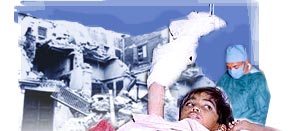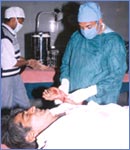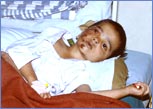The Rediff Special/Ramesh Menon


If you want to see hope in the devastated town of Bhuj, visit the field hospital that the Israeli army has set up there. It is an island of commitment. Everything in the hospital is detailed, systematic. The staff, dressed in neat uniforms, move around efficiently, taking care of the constant incoming steam of patients.
One of them is eight-year-old Sachin Gusai, who is encased in a cast from hip to toe. His pelvic and thigh bones were fractured when a piece of mortar fell on him. Besides, there are injuries on his foot that need to be dressed every alternate day. Sachin does not mind, for the doctors pamper him. They gave him crayons and paper so that he can spend his time drawing. "None of his drawings reflect the trauma the child has been through," says a satisfied Sergeant Sharon Aks of the Israeli Defence Force. One shows a house, without any cracks. Another one is a scenic portrayal of birds, trees and mountains.
This was not always the case with Sachin. Earlier, after the quake, he would mutter in his sleep, was incoherent in his speech and talked of death and dead bodies being taken away. Now, though, the doctors expect him to be back on his feet in six weeks.

His father Gulab recounts what happened. The quake had split their flat into two and the staircase had disappeared. Somehow, he and his wife managed to remove the mortar slab that had fallen on their son and, thanks to the help of some kindly strangers, reached the ground. They rushed their son to the Referral Hospital at Anjaar. Only to find out that the hospital had collapsed. There was just one doctor around, but he was in shock since his house, too, had collapsed.
They then came to the field hospital set up by the government in Bhuj, which was in total chaos. Besides, the facilities were pathetic. Incidentally, even 10 days after the quake, workers were still setting up prefabricated rooms for the different wards. Depressed, he returned home. Then someone told him about the Israeli field hospital that had just come up.
On January 29, six planes winged their way from Israel to Bombay. They were carrying about 300 Israeli volunteers who were eager to help earthquake survivors. Among them were doctors, nurses, paramedics and other technical personnel. After a bit of bureaucratic red-tapism, they landed in Bhuj at around 11 pm on January 30. And immediately got to work, setting up tents that would house the various wards of the hospital.

"The only ones who were allowed to sleep were the doctors, nurses and paramedics. They needed to recuperate so that they would able to treat the patients and attend to the emergencies," says Aks. After about 12 hours of work, the field hospital started taking shape. Giant generators were set up and sophisticated equipment tested. By 1 pm the next day, the hospital was thrown open to the public.
Soon, they were busy. Eightyfive per cent of their patients came in with orthopaedic injuries; the Israelis had the foresight to bring both an independent X-ray unit as well as a sophisticated laboratory with them. "We can detect any infection in the body with the equipment we have here," says biologist Albert Abchee.
A few heart patients were admitted into the intensive care ward, where they recuperated with the attentive care that was showered on them. The operation theatre, too, was very busy. There were around 30 amputations, a Caesarian and a skin transfer. A special ward was dedicated to all those going into or coming out of surgery.
Another ward took care of those suffering from gynaecological problems. While thousands died in around Bhuj, eight children were born in the hospital -- two of them are still on incubator; one has an intravenous tube stuck into the right hand to prevent dehydration.

The paediatric ward saw hundreds of children suffering from broken bones -- some of them had to have their limbs amputated -- dehydration and other ailments. The children were kept amused with balloons, which the team had brought with them from Israel. In fact, every little detail had been taken care of before they flew to India.
It is evident in the fact that the team includes a psychiatrist and a social worker, who are on hand to counsel the doctors. The older doctors, who have nearly two decades of working experience in such situations took Bhuj in their stride, but the young paramedics who are in their early twenties did need counselling. As did many of their patients.
A group of Israeli doctors visit Bhuj daily to help those who cannot visit the hospital or do not know about it. "All of us chose to come here," says Yitzhak Abena, a specialist in internal medicine and cardiology. "None of us were ordered to go on the team, which is the biggest one we have ever sent."
Yitzhak should know. He says they knew how it feels when many innocent people are killed in in one place. Which is why they share a solidarity with the quake victims. "We are so glad we were able to save so many lives," says Yitzhak. "My father was the only survivor in his family in Poland, the rest of them were wiped out in the Holocaust where millions of Jews died. We all understand suffering."
In another week, the Israelis will leave for home. But the residents of Kutch will remember them with gratitude.
Like Jayantilal, a painter from Supar village, near Bhuj. His six-year-old son, Roopesh Kumar, had severe lacerations on his nose; a stone fell on it. A Israeli plastic surgeon operated on him and, by the tenth day, he was fine. Yitzhak jocularly tells Jayantilal the operation was done so well that there will be no scars; he should have no problem finding his son a beautiful bride.
Jayantilal does not say anything. He just stands there looking at the doctor. But his smile, and his eyes, speak volumes.
Design: Lynette Menezes
The Complete Coverage | List of earthquake sites
Back to top